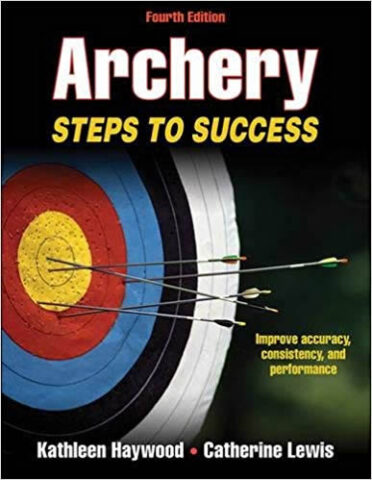Archery Steps to Success by Kathleen Haywood and Catherine Lewis
 There are around 240 pages in this slightly larger sized book with a glossary in the rear of the book. This review is based on the 4th edition. Lots of images in full colour make this book easy to read and very clear for the beginner. There are even exercises at the back of each chapter allowing you to score yourself. Archery Steps to Success covers compound and recurve bows in equal measure which is nice to see.
There are around 240 pages in this slightly larger sized book with a glossary in the rear of the book. This review is based on the 4th edition. Lots of images in full colour make this book easy to read and very clear for the beginner. There are even exercises at the back of each chapter allowing you to score yourself. Archery Steps to Success covers compound and recurve bows in equal measure which is nice to see.
Instead of chapters this book is split into Steps – hence the name of the book Steps to Success. The 11 steps are fitting equipment, shooting safely, shooting with good form, refining technique, aiming and sighting, anchoring and releasing, analysing performance, upgrading – tuning and maintaining equipment, sharpening your mental skills, competing in target archery and bow hunting.
Step 1 covers the different types of archery, the different types of bow used and the accessories for the bow and archer. It also covers how to fit your equipment to yourself, arm guards, finger tabs etc. It also looks at how to determine your eye dominance, draw length and draw weight for your first bow.
Step 2 is a bit shorter in length but very important as it covers shooting safely. This includes making sure your arrows are the correct length, your posture is correct, retrieving arrows and that your attire is correct.
Step 3 introduces archers to the T form and shooting with good form with a recurve bow. It’s not until Step 4 where the shooting technique is refined by looking more at stance, hand position and back tension in your shooting. This step is all performed using a recurve bow in the book.
Step 5 introduces us to bow sights of recurve and compound bows. It also shows you how to make simple bowsight on a training bow. It covers peep sights, how to use a sight and adjust it. The end of this step also covers barebow aiming and sighting.
Step 6 covers anchoring an release. This introduces kisser buttons, anchor positions on the face and anchoring with a mechanical release.
Step 7 is all about analysing your performance, so here the book looks at your arrow groups on the target face as well as errors that affect horizontal and vertical accuracy. Overcoming target panic is also addressed along with all types of shooting error including follow-through errors.
Step 8 is all about upgrading equipment and fine tuning. This chapter concentrates on adjusting arrow flight and aligning your bow whether it’s a recurve or compound bow. There is also information on fletching arrows and building up arrows and how to maintain your bow.
There is then a little chapter or step about mental skills and then it’s onto competing in target archery with information on how to score and dealing with adverse weather conditions whilst shooting. The final chapter or step is about bow hunting mainly using a compound bow. This step looks at hunting arrows and shooting downwards and up an incline. 3D targets and field archery are also discussed.
Overall this is a very good archery book for beginners, it’s very easy to read and clear with some great colour images and the book is quite large as well.
